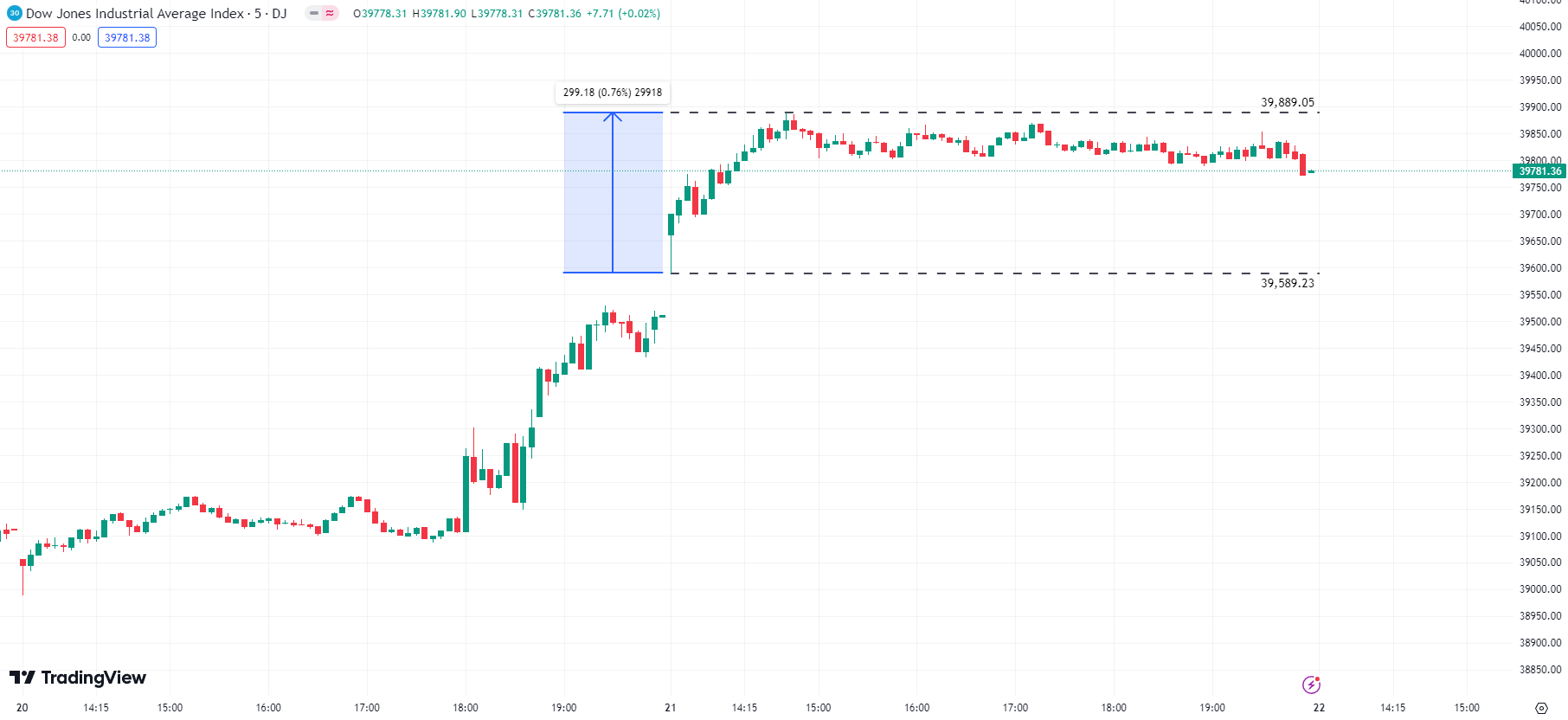Dow Jones climbs into another record close, taps 39,880 on Thursday

- Dow Jones clips into its second all-time high in two days.
- US equities broadly higher in the back half of the trading week.
- DJIA climbs 0.8% on Thursday as traders extend Fed bid.
The Dow Jones Industrial Average (DJIA) tore into its second all-time high this week, climbing eight-tenths of a percent and tapping a fresh record peak of 39,889.05 as US equities broadly gain ground. Investor confidence is peaking after the Federal Reserve (Fed) held steady on interest rates at the March Federal Open Market Committee (FOMC) rate call on Wednesday. Still, Fed Chairman Jerome Powell nodded at the likelihood of rate cuts to come, sending broad-market risk appetite into the ceiling.
Of the 11 sectors that make up the US equities markets, all but two ended Thursday in the green. The Industrials Sector ended the day up an even 1.0%, closely followed by the Financials Sector, which ended the day up 0.85%. The Utilities and Communications Services Sectors fell to the bottom on Thursday, falling -0.21% and -0.17%, respectively.
Dow Jones news
The Dow Jones climbed nearly 300 points bottom-to-top on Thursday as the index bears down on the 40,000.00 major price handle. The DJIA ended Thursday just below 39,800.00, but holding firmly in record territory and etching in the index’s highest closing price ever.
Of the 30 securities listed on the DJIA, 11 ended Thursday in the red with losses largely restrained below half a percent, but Apple Inc. (AAPL) was the day’s loss leader, which shed over 4% to trade into $171.00 per share after the US Department of Justice announced it was suing the company on the accusation that Apple’s iPhone ecosystem constitutes a monopoly. The Department of Justice accused Apple of anti-competitive practices in multiple areas of the megacompany’s mobile phone business. The AAPL ticker is down nearly 8% from recent all-time highs at $198.11 set last December.
Goldman Sachs Group Inc. (GS) led the charge up the Dow Jones market board on Thursday, climbing 4.35% on the day to close just above $413.70 per share. GS is followed by Home Depot Inc. (HD), which climbed over 2.8% to test $395.20. Caterpillar Inc. (CAT) gained slightly over 2.5% to hit $363.56 at the closing bell.
Dow Jones Industrial Average technical outlook
The Dow Jones kicked off Thursday’s US trading session with a topside gap as investors scrambled to bid up US equities, rallying into a fresh all-time record peak at 39,889.05 before settling into sideways trading between 39,840.00 and 39,820.00. The day’s low was set early in the trading session at 39,589.23.
Sellers looking to close Thursday’s opening bullish gap will need to drag the index below 39,520.00, which would open the Dow Jones up for a further decline into the last swing low into the 38,600.00 region.
Dow Jones Industrial Average 5-minute chart
Fed FAQs
Monetary policy in the US is shaped by the Federal Reserve (Fed). The Fed has two mandates: to achieve price stability and foster full employment. Its primary tool to achieve these goals is by adjusting interest rates. When prices are rising too quickly and inflation is above the Fed’s 2% target, it raises interest rates, increasing borrowing costs throughout the economy. This results in a stronger US Dollar (USD) as it makes the US a more attractive place for international investors to park their money. When inflation falls below 2% or the Unemployment Rate is too high, the Fed may lower interest rates to encourage borrowing, which weighs on the Greenback.
The Federal Reserve (Fed) holds eight policy meetings a year, where the Federal Open Market Committee (FOMC) assesses economic conditions and makes monetary policy decisions. The FOMC is attended by twelve Fed officials – the seven members of the Board of Governors, the president of the Federal Reserve Bank of New York, and four of the remaining eleven regional Reserve Bank presidents, who serve one-year terms on a rotating basis.
In extreme situations, the Federal Reserve may resort to a policy named Quantitative Easing (QE). QE is the process by which the Fed substantially increases the flow of credit in a stuck financial system. It is a non-standard policy measure used during crises or when inflation is extremely low. It was the Fed’s weapon of choice during the Great Financial Crisis in 2008. It involves the Fed printing more Dollars and using them to buy high grade bonds from financial institutions. QE usually weakens the US Dollar.
Quantitative tightening (QT) is the reverse process of QE, whereby the Federal Reserve stops buying bonds from financial institutions and does not reinvest the principal from the bonds it holds maturing, to purchase new bonds. It is usually positive for the value of the US Dollar.
